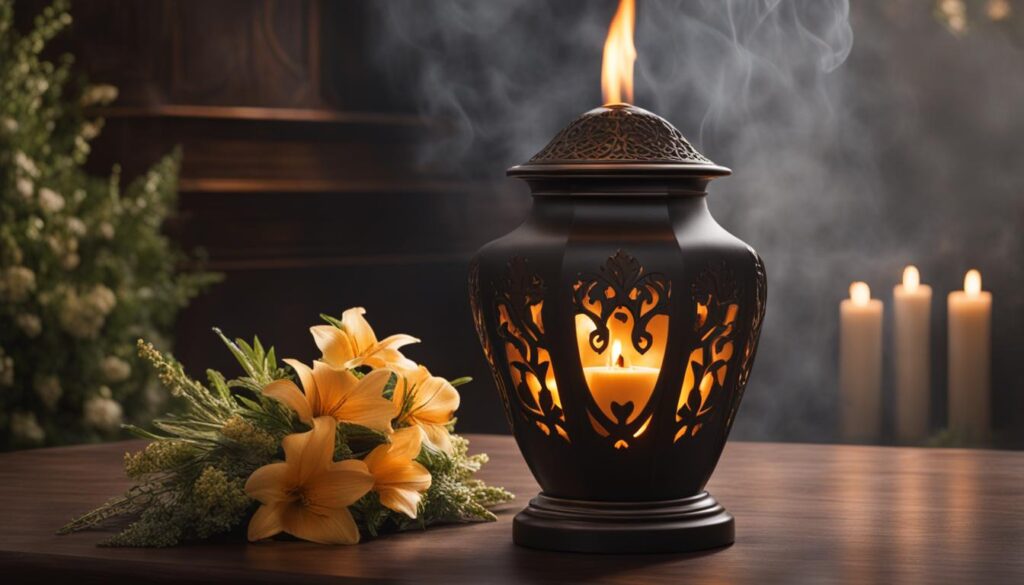We may earn money or products from the companies mentioned in this post.
When a loved one passes away, one of the most difficult decisions you may face is how to lay them to rest. One option that has gained increasing popularity in recent years is cremation. Not only is it typically less expensive than traditional burial, but it also offers a variety of options for memorialization.
However, with so many cremation processes and options available, it can be overwhelming to navigate the decision-making process. That’s why we’ve created this guide to provide you with a comprehensive understanding of the various cremation methods, services, and planning involved. By the end, you’ll have the knowledge and confidence to make informed decisions during this difficult time.
Key Takeaways:
- Cremation processes and options provide families with a wide range of choices for laying their loved ones to rest.
- Understanding the different cremation methods is crucial in selecting the best option for your family.
- Cremation services can range from simple and direct to traditional with a ceremony.
- Proper cremation planning is essential to ensure your loved one’s final wishes are respected.
- With cremation, families can choose from a variety of memorialization options to honor their loved ones in a personalized way.
Traditional Cremation: A Time-Honored Choice
Traditional cremation has been a popular choice for decades, and it offers a meaningful and respectful way to honor your loved one’s life. It involves a step-by-step process that includes a cremation ceremony and memorialization with cremation urns.
The ceremony can take place before or after the cremation, and it provides an opportunity for family and friends to gather and pay their final respects. The ceremony can be personalized to reflect the beliefs and values of the deceased, and it can be held in a funeral home, place of worship, or another suitable location.
After the ceremony, the cremation process begins, which involves placing the body in a cremation chamber. At temperatures ranging from 1,400 to 1,800 degrees Fahrenheit, the body is reduced to bone fragments, which are then processed into fine ash, also called cremains.
Once the cremation is complete, the family can choose from a wide variety of cremation urns to hold the cremains. Traditional urns, such as those made from ceramic or bronze, are common options, but families also have the option of choosing more personalized and unique urns, such as those made from wood, glass, or other materials.
| Pros | Cons |
|---|---|
| Allows for traditional memorialization and grieving process | Can be more expensive than direct cremation |
| Provides closure for family and friends | May not align with the deceased’s wishes if they preferred a simpler disposition method |
| Religious or cultural traditions can be incorporated into the ceremony | May require additional planning and coordination for the ceremony and burial or scattering of ashes |
“The traditional cremation ceremony was a beautiful way for our family to say goodbye to our grandfather. We were able to incorporate his love for nature into the ceremony and scatter his ashes in his favorite park. It was a meaningful and emotional experience for us all.”
Overall, traditional cremation can be a fitting choice for those who want to celebrate the life of their loved one in a meaningful and traditional way. With its time-honored ceremony and a wide variety of options for memorialization with cremation urns, it allows families to say their final goodbyes and honor their loved one’s memory in a respectful and personalized manner.
Direct Cremation: A Simpler Farewell
Direct cremation has become an increasingly popular option for families who prefer a more straightforward approach to the cremation process. This option allows for the cremation of the deceased without any prior funeral services or visitation.
During direct cremation, the deceased is transported to the crematory, and the cremation process takes place without any ceremonial or religious involvement. Families who choose direct cremation have the option to hold a memorial service at a later date, allowing for a more personalized and meaningful tribute.
As with any type of cremation, families can choose from a variety of cremation urns to hold the ashes of their loved ones. Direct cremation typically has a lower cost than traditional cremation services, making it a practical choice for those who are on a budget.
| Pros | Cons |
|---|---|
| Lower cost compared to traditional cremation | Does not allow for a traditional funeral service |
| Allows for a more personalized memorial service at a later date | Limited options for displaying the remains |
| More environmentally friendly compared to traditional burial | Does not provide closure for some individuals |
Direct cremation services are widely available and can be arranged through funeral homes or cremation providers. These services typically include the transportation of the deceased to the crematory, the cremation process, and the return of the ashes to the family. Additional services such as the scattering of the ashes or the creation of memorial jewelry can also be arranged through cremation providers.
Overall, direct cremation offers a practical and cost-effective option for families who prefer a simpler farewell. With a wide range of cremation urns and memorialization options available, families can create a personalized tribute that honors their loved one’s memory.
Green Cremation: An Environmentally Conscious Option
With more and more people prioritizing sustainability, green cremation, also known as eco-friendly cremation, is becoming an increasingly popular option. This method uses innovative technology to provide a more environmentally conscious way of handling cremated remains.
Cremation Methods
Green cremation uses two primary methods: aquamation and flameless cremation. Aquamation, also called alkaline hydrolysis, dissolves human remains using water, alkali, and heat. This process produces fewer greenhouse gases and uses less energy than traditional flame cremation.
Flameless cremation, also known as resomation or bio-cremation, utilizes water and alkali solution to dissolve the remains. The process produces fewer greenhouse gases and uses less energy than traditional flame cremation.
Memorialization Options
There are several eco-friendly ways to memorialize a loved one who has undergone green cremation. One option is to plant a tree with the cremated remains. This allows the remains to nourish new life while also serving as a living tribute.
Another option is to scatter the ashes in a natural setting, such as a forest or a beach. This allows the remains to return to the earth, without leaving behind the environmental impact of traditional burials.
Cremation jewelry is also available for those who wish to keep their loved one close. This type of jewelry incorporates a small amount of the cremated remains into a piece of jewelry, allowing the wearer to carry a piece of their loved one with them.
In conclusion, green cremation offers an eco-friendly alternative to traditional cremation. Using methods such as aquamation and flameless cremation, it provides a more sustainable way of handling cremated remains. By choosing green cremation, families can memorialize their loved ones in environmentally conscious ways, such as planting a tree or scattering the ashes in a natural setting.
Conclusion
When planning for the final disposition of your loved one’s remains, it’s essential to understand the various cremation processes and options available. This guide has provided comprehensive insights into traditional, direct, and green cremation methods, along with memorialization options like cremation jewelry.
Cremation Planning
Planning for cremation involves making difficult decisions during a challenging time, so it’s vital to consider all available options. Understanding the processes can help you make informed decisions and ensure that the final tribute aligns with your loved one’s wishes.
Cremation Jewelry
Cremation jewelry offers a unique way to keep your loved one close to your heart. It’s a physical reminder of your loved one’s memory and can provide comfort during the grieving process. With various options available, you can choose a piece that perfectly represents your loved one and their personality.
Overall, choosing the right cremation process and options depends on personal, cultural, and financial considerations. This guide has provided valuable insights into the different methods and options, allowing you to make an informed choice that honors your loved one’s memory in a meaningful way.
FAQ
What is cremation?
Cremation is a process that reduces the human body to ashes through intense heat. It is an alternative to traditional burial and is becoming increasingly common in the United States.
How long does the cremation process take?
The length of the cremation process can vary depending on factors such as the size of the individual and the temperature of the cremation chamber. On average, it takes approximately two to three hours to complete the cremation process.
Can I witness the cremation process?
Many crematories offer the option for family members to witness the beginning of the cremation process. This can provide a sense of closure and reassurance for loved ones.
What happens to the remains after cremation?
After the cremation process is complete, the remains, also known as cremated remains or cremains, are typically placed in an urn or another container chosen by the family. The family can then decide whether to keep the urn at home, scatter the ashes in a meaningful location, or choose another form of memorialization.
Can I still have a funeral or memorial service with cremation?
Absolutely. Choosing cremation does not mean you cannot have a funeral or memorial service. In fact, many families opt to hold a traditional funeral or memorial service before or after the cremation process. This allows family and friends to come together to honor and remember their loved one.
What are the costs associated with cremation?
The cost of cremation can vary depending on factors such as your location, the specific services chosen, and any additional memorialization options. It is best to consult with a funeral home or crematory for a breakdown of the costs involved.
Can I still have a viewing if I choose cremation?
Yes, you can still choose to have a viewing or visitation before the cremation takes place. This allows family and friends to pay their respects and say goodbye to their loved one in a more personal way.
Are there any religious or cultural considerations with cremation?
Different religious and cultural beliefs have varying views on cremation. It is important to consult with religious leaders or cultural advisors to ensure that the chosen option aligns with any specific customs or practices.
Can I pre-plan my own cremation?
Yes, pre-planning your own cremation is a responsible and considerate decision. By pre-planning, you can outline your wishes and relieve your loved ones of the burden of making difficult decisions during an already challenging time.
Can I personalize the cremation process?
Absolutely. There are various ways to personalize the cremation process to reflect the unique life and personality of your loved one. From selecting a special urn or memorial jewelry to organizing personalized ceremonies or rituals, there are many options available to create a meaningful tribute.
Affiliate Disclosure: This post may contain affiliate links. If you purchase through our link, we may receive a small commission, but at no additional cost to you. For more information, please see our Disclosure statement.



